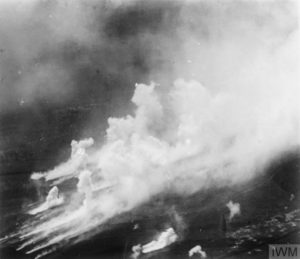Friday October 11th, 1918
Feeling better again.
Casualties
Frank is feeling better today, Meanwhile the Battalion has been relieved on the front line and moved to Rest Billets in Reumont.
The Description of Operations today provides a summary of the casualties over the last few days. It includes the information that on October 7th, Lt KH Allen and 7 OR were wounded when they went in advance to the line to prepare for the Battalion’s arrival. Lt Allen died today.
‘The casualties for the period 7th to 11th October inclusive were as under:-
Killed – 1 Officer and 10 OR
Wounded 7 Officers and 98 OR
Died of Wounds 2 Officers and 3 OR‘
21 officers and 708 other ranks had participated in the offensive. Over 40% of the officers and 16% of the other ranks were casualties.
Overall, Cambrai-St. Quentin had been a costly battle and the British had suffered 140,000 casualties. As such they will need time to reorganize at all levels, including the 9th Bn, and to bring up their artillery before the next assault.º
Blue Cross / Sneezing Gas
Yesterday the Battalion noted that enemy artillery ‘fired a number of rounds of Blue Cross (Sneezing Gas) causing gas masks to be worn.’
There were several types of gases used in WWI. The classification used by British medical historians was:
- acute lung irritants;
- lacrymators;
- direct poisons of the nervous system or paralysants;
- sensory irritants of the eyes, nose, and upper respiratory passages (sternutators);
- skin irritants (vesicants).²,¹
Sneezing Gas was a sternutator.
‘THE STERNUTATOR gases or nasopharyngeal irritants were nonlethal. They were capable, however, of producing extreme irritation of the nose, throat, and eyes, caused severe headache and nausea. The symptoms were comparatively short in duration, and the gases were not effective when the mask was worn. The inhalation of these gases before the application of the mask made mask wearing very uncomfortable and was apt to cause its premature removal and thus to subject the wearer to the effects of more important gases which usually accompanied or immediately followed the use of the sternutators. This type of gas usually arrived in the nature of a surprise, since it was used in high explosive shells. Because of this it was difficult for the troops to recognize immediately the presence of the gas. A good example of this type of gas is diphenylchlorarsine, which was long and extensively used at the front.’¹
Colour Coding of Gas Shells
The Germans had a coding system for their shells to indicate what type of gas each one contained. This system comprised coloured crosses and numbers (the latter to indicate the particular mixture of gases being used).
- Yellow crosses – acute lung-irritants, e.g. mustard gas.
- Green crosses – used on pure gas shells containing skin irritants (vesicants) or tear gas (lacrymators).
- Blue crosses denoted sneezing gas (sternutators). These were usually high explosive gas shells that would fragment on impact and cause wounding as well as gas clouds.

The Germans also instructed the artillery on what percentages of shells to fire dependent upon the situation they faced. For example,
‘Fire against infantry-creeping barrage (calibers, 77 mm., 105 mm., 150 mm., howitzers):
Explosive shell 60%
Blue cross gas shell 30%
Green cross gas shell 10%’¹
Yellow cross shells were only used when the Germans did not plan to enter the territory into which they were fired. Mustard gas contaminated land and foliage and therefore would poison passing troops long after it was initially used.
As demonstrated by the Battalion yesterday, the markings on the shells were soon known to the Allies. This helped to determine the course of action required. The photograph shows a gas attack photographed from the air and shows just how horrendous it must have been for those on the ground.* However the 9th seemed to take it in their stride – all their anti-gas training must have paid off.
9th Battalion War Diary – 11th October 1918 – Reumont
Battalion relieved in the line by the 2nd Bn Northumberland Fusiliers before midnight and moved into rest billets at Reumont.
References & Further Reading
º Battle of the Selle 17-25 October 1918 on History of War site
¹ Medical Aspects of Gas Warfare WWI, on WWI, The Medical Front, vlib
² ‘History of the Great War, Based on Official Documents. Medical Services. Diseases of the War, Volume II, Including the Medical Aspects of Aviation and Gas Warfare, and Gas Poisoning in Tanks and Mines.’ London, HMSO; 1923, D 252 (information provided in ¹)
* Q 27526, copyright Imperial War Museums


